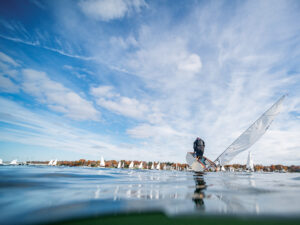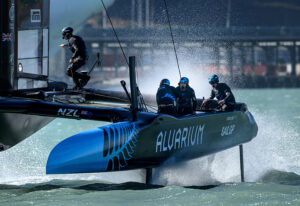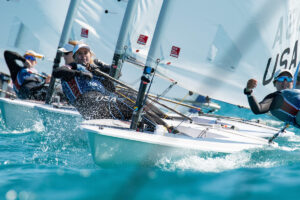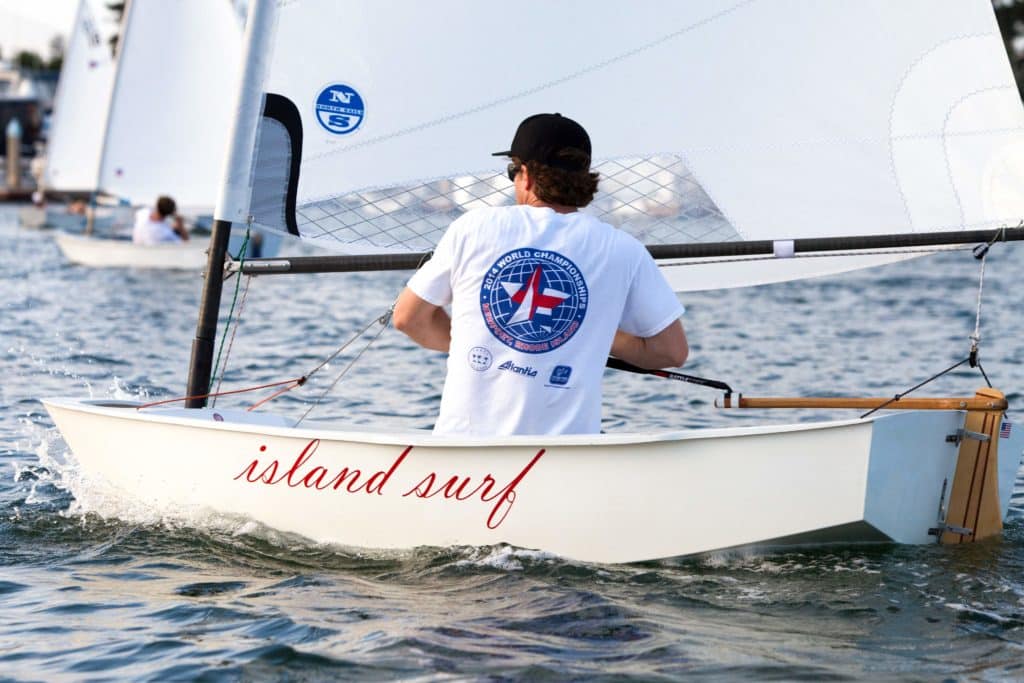
This past spring, I started sailing a Naples Sabot, which is a Southern California kids’ boat, somewhat like an Opti. There have always been adults, as well as kids, in this class, but when the pandemic hit, a lot of other adults jumped into the class, if nothing else, just to get on the water. As a result, San Diego YC’s Monday night fleet rapidly grew to around 25 very competitive boats.
If you’re unfamiliar with the Sabot, it’s an 8-foot, 95-pound cat-rigged dinghy, with a leeboard hanging off on the starboard side. They’ve been around since 1946. I didn’t sail Sabots or Optis growing up, so this was new territory for me—and light-years from the big J/70, Etchells and Melges 20 programs I’ve been involved in lately.
I bought a boat for my kids and myself, finally had some free time, and I was eager to go out and do well. My first Monday night race was OK, but I was slow for sure. I kept it clean on the starting line—all good starts away from the crowd—but the faster boats were clearly faster than me, so I really had no hope of doing well no matter how good my starts were. The next week I made it my mission to get out on the course early and do some experimenting, familiarizing myself with the boat to get faster. And it worked.
I got out an hour and 45 minutes early and first did a lap, upwind and then downwind, just to get a feel for the shifts and the boat, like we all usually do. The Sabot course at SDYC is small, so a lap took only about 10 minutes. Then I went through a series of upwind and downwind drills that really fast-tracked my boatspeed. They’re drills you can do on your own and on just about any boat. When finished, you’ll have a much better sense of your boat’s potential, and they will really free you up to focus on tactics. Plus, they will allow you to get around the course faster and hang in situations where you used to have to bail to allow you to continue sailing the right way.
The key, being out there by myself, was that there were no distractions. I wasn’t tuning with someone else; it was the wind, the water and me. Everything revolves around the senses. You’ve got to listen to how your boat is moving through the water, feel the helm in your hand and the tension on the sheets. If you’re on a bigger boat with a knot meter, it can be good to watch the speed for feedback, but you’re really just trying to get a feel for the boat. Stable heel angle is fast. Upwind in a keelboat, it might be 15 degrees of heel, and in a dinghy, it’s dead flat. But regardless of your angle of heel, it needs to be stable to go fast. You can adjust your heel angle through steering, sheet adjustment and weight placement. My goal for the practice session was to isolate each of those three techniques, one lap for each, and eventually put them all together for maximum smoothness.
First, I sailed a beat keeping the boat dead flat by just easing and trimming the main, with no steering and no weight movement. To do this, you might have to overease or trim the sail pretty hard to keep the boat flat, more than you’d do in a race, but that’s fine. I’m learning how much trim I need to keep from heeling to windward and how much ease I need to prevent too much heeling. I was also curious when the front of the main would start luffing on the big eases. In a race, I’d probably head up and hike a little bit rather than overeasing, but right now, I’m just working on the main.
On the next upwind, I focused on steering. I left the mainsheet alone, headed up in the puffs to flatten the boat, and bore away in the lulls for more power to keep the boat from heeling to windward. If there was a gross change in wind, I’d adjust the main a little, but I was working on just steering—sometimes oversteering—to keep the boat stable. Maybe, with the main cleated, you head up so much that to stay flat, the front of the main starts luffing. That’s OK. Then maybe a big lull comes where you have to bear away so much to keep from heeling to windward that you’re too low. Again, that’s fine, because you’re feeling the boat and learning how heading up and bearing away affects power. And you’re quickly learning the range you’ll be working in during a normal race. You might learn that the boat doesn’t slow down as much as you thought it would when heading up to keep it flat. And, when pinching, you might learn where the boatspeed falls off the cliff, or drops considerably.
The next upwind run, I focused on keeping the boat stable mainly by using my weight—scooting in for lulls and hiking in the puffs. Pretty straightforward stuff.
While doing all of the drills, the goal was to keep the boat flat. In a dinghy, to figure out what flat actually is, pay special attention to the helm. You need to feel what the helm is telling you: You’re looking for it to be neutral, dead in your hand—with no tug either way—so the boat would want to go straight if you were to let go of it. In addition to feeling the tiller, I also look at the bow as an indicator of heel angle. In a Sabot, I watched the square bow, keeping the flat edge parallel to the water. If you have a jib, watch the angle of the forestay to the horizon. Either way, it all comes down to feeling the helm.
Now that I had practiced those three areas, on the fourth upwind test, I put it all together. All of a sudden, the boat felt really nice, and all of my actions where smooth. And smooth is really fast. By practicing each of those variables and going to the extreme with them, I learned the bookends, so speak—what’s too much trim, what’s too much ease, how much I need to steer, how much I need to move my weight. And now, putting all those three together in concert, I was more frequently in the sweet spot. As a result, I had to do everything much less—only a little bit of weight movement, a little bit of steering, a little bit of trim in or out—and the boat was cruising along with a very stable heel angle. All that in just 35 to 40 minutes of upwind sailing.
Once happy with my steering, trimming and weight movement, I worked on fore and aft weight placement and modes. With its square, flat bow, you can really hear if your weight is too far forward. Scoot back too much, and you can see and hear the stern wave increase in size. Sailing in the sweet spot, where the bow and stern are quiet, is fast. The same is true, to varying degrees, for all boats.
To get the fore-and-aft trim right on the Sabot, I learned that I needed to scoot back in the puffs and forward in the lulls. I could feel it, and I could hear it, and I experimented. The key is to overdo it. Try being clearly too far forward, and listen to what it sounds like. Now move too far back, and listen. You’ll quickly discover that one position is OK, but moving a bit farther is wrong. You’re figuring out the range of where you should be, the sweet spot. It might not be one specific sweet spot, but it’s the range. In the Sabot, I learned it was pretty sensitive and that I had to shift aft more than I thought when the breeze was stronger. When I went from inside the boat to hiking, I had to scoot back almost a foot to get the trim correct—and this is a tiny boat! If you have a knot meter, you’d really be looking at that too for feedback, but you’re still listening and feeling.
Next came modes, something I’m positive people don’t do but is really important. First, I tried a low, fast mode. I sailed lower and lower, while easing the main to match, and felt the boat and its speed increase. Then a little lower and a little lower yet until I could see that I was clearly sailing way too low and too fast. But I was experiencing the boat and its capabilities, learning the range, and figuring out what was clearly too low. In doing so, I also learned how much the boat accelerated when I put the bow down and eased the mainsheet. Sometimes, with just another degree or two down, boats will accelerate much more than you think. Knowing this can come in handy during a race.
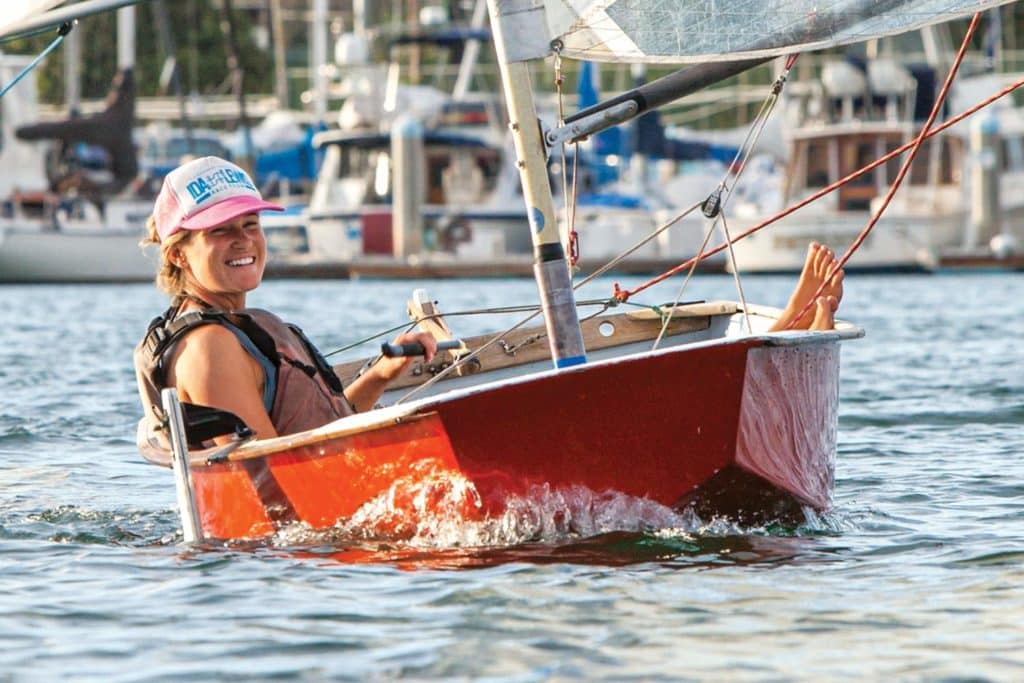
Then I transitioned into experimenting high-mode sailing. Since the Sabot has no jib, I’m wondering: OK, if I trim the main tighter, how high can I point? When does the boat start to slow down? If I have a knot meter, when do I see the speed start to crash? And how much did it slow down? Maybe it slowed down just one-tenth of a knot. Well, that’s not that bad. Let me try a little higher, a little tighter main. When pinching, at some point the boatspeed will crash. I want to find that point. Once I do, I’ll then know where I’ll be sure not to go.
I then practiced skirting that too-high edge without crossing it. This would allow me to hold lanes during the race and/or make a weather mark if I slightly understood or get a left shift just before rounding. While practicing the high mode, I worked on learning how to pick laylines by choosing a reference on land or a nearby buoy. Then I observed how much leeway I was making. Am I gaining height on a buoy while pinching? What if I pinch too much and stall out? Do I go sideways? This is all great knowledge to have about your boat.
Ultimately, since I had to tack while sailing upwind, I experimented with different styles of tacking—different rates of turns, different amounts of rolling. I learned it was key to be smooth with a slightly fast turn but not roll too hard. By doing so, I’d lose less in each tack. Always assess tacking penalties, regardless of what boat you sail, so you can factor in that to your tactics. The bigger the tacking penalty, the less you should tack.
Grooving Downwind
With all those upwind sessions, I had six to eight downwind runs as well. There I practiced different heel angles and different ways of sitting in the boat so I could be comfortable. It’s a really small boat and I’m big, so it’s super-sensitive to any movement. I looked at how I could adjust heel angle while still being smooth. I felt the boat when puffs hit and learned how to move to keep the heel stable during those changes. I also played around with sail shape—how eased should I have the main, how tight should it be? How much vang should I use—what’s clearly too much, what’s clearly too little?
While experimenting with this, I also worked with which wind angle felt best. Once I found an angle that felt good, I headed up a little and felt what that was like, then bore off a little and felt what that was like. All the while, I tried to find the acceptable range.
After getting comfortable with main trim and wind angle, I opened up my range by swerving around, Laser-style—big bear-aways with some ease, then heading up with trim. I focused on proper main ease to help bear away and how quickly to trim in while heading up. I also practiced a few different types of jibes and experimented with the mechanics of trimming—do I pull the sheet from the ratchet block or directly from the boom? And how do I transition my weight smoothly from one side of the boat to the other? I tried leeboard up a little, leeboard down. And after fumbling around, I figured that I would just leave it alone and focus on heel angle and tactics. I was constantly evaluating what felt good and what didn’t, eliminating processes and styles that didn’t work.
Fast-forward to that evening’s racing. It’s the third race, and we’re sailing upwind on port tack. We’re in a big lift, and down to leeward is a 12-year-old sailor, Anton Schmid, the current Sabot national champion. He’s bow out on me and pointing to the moon. It’s blowing around 3 knots, he weighs 80 pounds less than me, and he’s going to pinch me off in about 30 seconds. I really don’t want to tack because I’m almost aiming at the mark, and tacking in 3 knots is painful. So I start pointing, practicing what I had done earlier, a super-high mode without stalling and falling off the cliff. I’m trying to stop the bleeding and hold my lane as long as possible. He’s still gaining on me, and eventually it gets to the point where he is starting to affect me, but it takes one minute instead of 30 seconds.
I still really didn’t want to tack, so I ease the main and foot through his lee. I immediately think, I practiced this two hours ago. It’s the low and fast mode. I knew it was too low for VMG sailing, but it fit my goal perfectly in this moment because I didn’t want to tack, and I wanted clear air again. Once in a clean lane, I head back up, go into the normal upwind mode, and let him point up and away from me. My lane gets better and better because I am in a normal mode, and he is in a high mode. I’m still on the long tack waiting for the next shift. Lo and behold, before I get to the weather mark, a little righty comes to me. I tack and round the mark fourth. Had I tacked away or stayed in his bad air, I probably would have been 12th. The run gets really weird and light, and I’m able to stay in the puffs and finish a strong second. That striking-distance position was set up by my moding on the first beat to keep sailing the shifts.
A few other times that evening my moding practice paid off, allowing me to sail the shift and go the right way by either holding high to keep a lane on a pointer or footing fast forward to the next shift. Luckily, at the end of the regatta, I had the least net points before the drop—a much better result than a week earlier, all attributed to my training.
The point of all of this, of course, is to find the extremes of your boat’s performance, upwind and downwind. It really teaches you about your boat’s capabilities and helps you keep it going fast all the time. By learning the extremes, your mental autopilot becomes much stronger. Your subconscious mind can keep it between the extremes while you are looking around and thinking about tactics, and your senses will be more attuned to your boat.
An added benefit is that it’s great for lane management. For example, in practice, you press the bow down a little bit and maybe gain a tenth or two of speed. But then you press a little more, ease the sheets a hair more, and gain a half a knot! It’s like, “Whoa! I didn’t even know that existed in this boat.” So now, suppose you’ve just started, and you’re going upwind with three boats above you that appear likely to roll you. Because of your practice, you now know that you can put the bow down, pick up a half-knot of speed, and end up bow out on them. Once there, you can return to your normal upwind mode.
Or suppose you’re sailing upwind and really like the way you’re going. You see this beautiful puff straight ahead, so you drop the bow down a little, pop the boatspeed up a half-knot, and just haul the mail to that puff. As you meet the puff header, you roll into a tack and you’re gone!
Or maybe downwind you like where you’re heading, but someone is starting to get near your breeze. You know exactly how much you can head up or fall off to keep a big lane and still have a solid VMG, all the while trimming accurately and keeping the heel correct—and, as a result, going fast. You can also use these moding tricks downwind to hedge toward more breeze and then spend more time in the puff.

